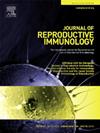Hidden diversity: Identification and characterisation of compartment-specific testicular macrophage populations
IF 2.9
3区 医学
Q3 IMMUNOLOGY
引用次数: 0
Abstract
Two major populations of resident macrophages have been identified in the mouse testis: interstitial tissue macrophages, characterised by high expression of CD206 and low or undetectable MHC class II antigen (MHCII) expression, and peritubular macrophages that generally lack CD206, but exhibit elevated MHCII. A morphometric analysis of macrophage subset marker antigens throughout the entire adult mouse testis was undertaken employing transgenic expression of the green fluorescent protein reporter at the locus of the Cx3cr1 gene (Cx3cr1gfp/+), and immunofluorescence localisation of F4/80, MHCII (I-A/I-E) and CD206. Compared with the testicular parenchyma encompassing the seminiferous tubules, the volume density of total macrophages (F4/80+) was 8–9-fold higher in the interstitial and peri-epithelial regions of the rete testis. Moreover, the majority of the interstitial and peri-epithelial macrophages in the rete testis were positive for both CD206 and MHCII – these double-positive macrophages were also numerous within and beneath the testis capsule. There was a small, but significant, increase (5–10 %) in the volume density of interstitial macrophages in the rete testis of mice with a heterozygous deletion of the Inhba (activin A subunit) gene. Macrophages increased considerably in the rete testis and adjacent testicular regions during infection with uropathogenic Escherichia coli. These data identify a substantial subset of macrophages within the mouse rete testis and subcapsular region that express both CD206 and MHCII, which comprises only a minor subset in the remainder of the testis. These double-positive macrophages may play a dual role in regulating tolerance to spermatozoa and responding to ascending infections.
隐藏的多样性:室特异性睾丸巨噬细胞群体的鉴定和表征。
在小鼠睾丸中发现了两种主要的巨噬细胞:间质组织巨噬细胞,其特征是CD206高表达,MHCII类抗原(MHCII)表达低或无法检测到;小管周围巨噬细胞通常缺乏CD206,但MHCII升高。利用绿色荧光蛋白报告基因在Cx3cr1基因位点(Cx3cr1gfp/+)的转基因表达,以及F4/80、MHCII (I-A/I-E)和CD206的免疫荧光定位,对整个成年小鼠睾丸的巨噬细胞亚群标记抗原进行形态计量学分析。与睾丸精小管周围的睾丸实质相比,睾丸网间质和上皮周围区域的总巨噬细胞(F4/80+)体积密度高8-9倍。此外,大多数睾丸网间质和上皮周围巨噬细胞CD206和MHCII均呈阳性,这些双阳性巨噬细胞在睾丸囊内和囊下也大量存在。杂合缺失Inhba(激活素a亚基)基因的小鼠睾丸网间质巨噬细胞的体积密度有微小但显著的增加(5- %)。感染尿路致病性大肠杆菌时,巨噬细胞在睾丸网和邻近睾丸区域显著增加。这些数据确定了小鼠睾丸网和包膜下区域内巨噬细胞的大量亚群,它们同时表达CD206和MHCII,而在睾丸的其余部分仅占一小部分。这些双阳性巨噬细胞可能在调节对精子的耐受性和对上升感染的反应中发挥双重作用。
本文章由计算机程序翻译,如有差异,请以英文原文为准。
求助全文
约1分钟内获得全文
求助全文
来源期刊
CiteScore
6.30
自引率
5.90%
发文量
162
审稿时长
10.6 weeks
期刊介绍:
Affiliated with the European Society of Reproductive Immunology and with the International Society for Immunology of Reproduction
The aim of the Journal of Reproductive Immunology is to provide the critical forum for the dissemination of results from high quality research in all aspects of experimental, animal and clinical reproductive immunobiology.
This encompasses normal and pathological processes of:
* Male and Female Reproductive Tracts
* Gametogenesis and Embryogenesis
* Implantation and Placental Development
* Gestation and Parturition
* Mammary Gland and Lactation.

 求助内容:
求助内容: 应助结果提醒方式:
应助结果提醒方式:


